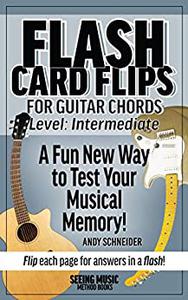Flash Card Flips for Guitar Chords - Level Intermediate Test Your Memory of Advancing Guitar Chords
- Книги
- 3-02-2023, 03:13
- 139
- 0
- voska89

Flash Card Flips for Guitar Chords - Level: Intermediate: Test Your Memory of Advancing Guitar Chords by Andy Schneider
English | 2022 | ISBN: N/A | ASIN: B08P8845DT | 102 pages | PDF | 0.80 Mb
For Advancing Guitarists: Just Like Flashcards for Math or Language - Learn Guitar Chords in a Flash! A Brand New Approach to Learning Music.
Flash Card Flips for Guitar Chords are a new and fun way to learn music and test your memory. Just like flashcards for math or languages, questions to test your knowledge are on one side of a page and the answers are on the back side. Open to a random page, read the question and then turn the page to check your answer.
At some time you've probably used flashcards to learn a subject. Your flashcards had a question on one side (Q: 2+2=?) and on the other side, the answer (A: 4).
Flash Card Flips works just like that! On each page you'll find a question such as "Play G9". On the backside of the page, you'll see the answer, which in this example is the fretboard diagram for G9.
Test your memory and knowledge of guitar chords.
Chord types are Dominant 9th, Dominant 7 sharp 9, Augmented, Diminished, Half-Diminished and Major Add 6/9. Solidify your knowledge of these frequently used, but more advanced chords.
Standard chord notation is used, like that you'll find with many songbooks. Fingerings and note names are included with each diagram.
Once you master the first set of questions, FLIP IT!
When you're ready for another challenge, turn the book upside-down for a more advanced set of flash questions.
One set of questions asks you to identify the name of the chord from the fretboard diagram which shows the fingering and note names. This is a great way to begin learning chords, even if you don't have a guitar in your hands. Just reading these diagrams is a good way to begin.
Flipping the book over, the second set of questions ask you to play a given chord. Then on the back side of the page is the answer: a fretboard diagram showing the fingering, chord symbol and note names. These are two different and complementary ways to expand your chord knowledge.
Links are Interchangeable - No Password - Single Extraction



